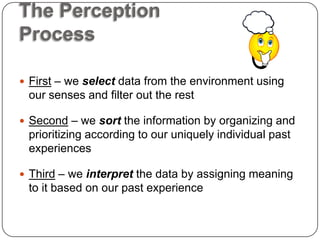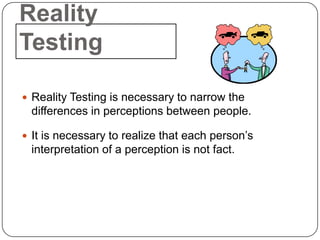Our perception is our reality crit thinking
- 1. Our Perception is Our Reality By Lisa Polydoros Speech 104 Professor Marteney
- 2. There is more to life than what we perceive On a cold January morning in 2007, a man played a violin in a busy Washington D.C. subway station during rush hour. Passersby stopped to watch for a minute, if that, and then some threw change into his violin case as a tip. After he was done playing, there was no applause, he just walked away quietly with the $32 he had made from tips for 45 minutes of playing. No one had noticed him leaving. If you had seen this, what would you think? That he is a homeless man trying to earn some money, right? So did everyone else. But, in fact…
- 3.  it was Joshua Bell, one of the greatest musicians in the world.  AND… he had just played 2 days earlier in a sold-out Boston theatre with tickets costing about $100 each.  AND… he was playing a piece by Bach that is one of the most intricate pieces of music ever written.  AND… the violin he was using was worth $3.5
- 4. Consider this…  What else might we be missing everyday?  My Perception, is my REALITY. Your perception is your REALITY.  We either place value on things to give them value, or do not place value on things and then they have no value.
- 5. What is YOUR Perception? ï‚— No 2 people perceive the same situation exactly the same way ï‚— We each take different meanings from different environmental messages everyday ï‚— We each use the perception process to accomplish this
- 6. The Perception Process  First – we select data from the environment using our senses and filter out the rest  Second – we sort the information by organizing and prioritizing according to our uniquely individual past experiences  Third – we interpret the data by assigning meaning to it based on our past experience
- 7. Recognizing Data: We recognize data:  Psychologically – by our mood and state of mind  Physically – by our physical condition (senses, age, health, fatigue, hunger, etc.)
- 8. Organizing Data: ï‚— Language helps us organize data ï‚— The more limited our vocabulary, the more limited our reality
- 9. Factors that Influence how we interpret data ï‚— Formal learning teaches us the socially correct view of our environment. ï‚— Experiences are informal learning occurrences. ï‚— Expectations are perceptions that we expect to conform to. ï‚— Closure is making sense out of data and filling in missing information if necessary. ï‚— Selective Perception is using heuristics as mental shortcuts to interpret the environment. ï‚— Patterning uses new perceptions to reinforce our current reality to avoid cognitive dissonance.
- 10. Reality Testing  Reality Testing is necessary to narrow the differences in perceptions between people.  It is necessary to realize that each person’s interpretation of a perception is not fact.
- 11. Reality Testing  Communication narrows the gap between people’s perceptions.  comparing realities lets us know if our perceptions are reasonable  examining a variety of realities might lead to the discovery of a more accurate reality  reevaluate your data if your reality cannot be validated by others  be sure to compare realities with a variety of people, not just those who are like-minded
- 12. Reality Testing  Become a better listener  Empathetic listeners can recreate another’s perspective by putting themselves in their position  Deliberative listening is for gathering information and content
- 13. Stati s ï‚— We all want a reality we are comfortable with ï‚— Statis is a reality on a particular subject ï‚— it is the absence of change in one more realities for an extended period of time ï‚— it is the existing state of things ï‚— it is physical and/or emotional contentment ï‚— it is our comfort zone ï‚— We perceive the world according to our stasis ï‚— We defend our reality as being the most accurate













